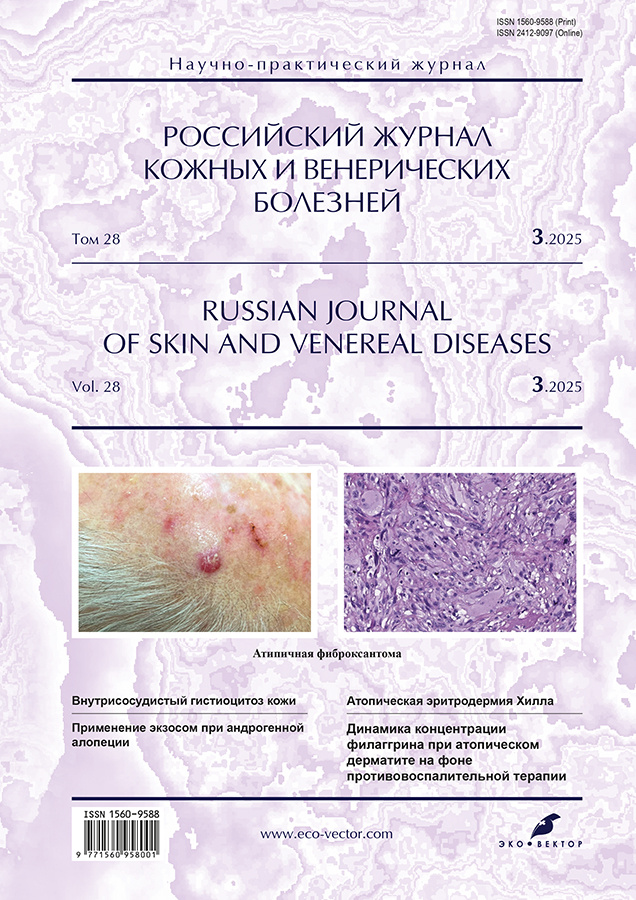Prevalence, clinical and epidemiological characteristics of acne, and morphofunctional properties of the skin in patients aged 18–25 years
- Authors: Aleksandrova O.A.1, Dubensky V.V.1, Dubensky V.V.1, Nekrasova E.G.1, Shneyder V.E.1
-
Affiliations:
- Tver State Medical University
- Issue: Vol 28, No 3 (2025)
- Pages: 301-310
- Section: DERMATOLOGY
- Submitted: 27.02.2025
- Accepted: 02.06.2025
- Published: 27.07.2025
- URL: https://rjsvd.com/1560-9588/article/view/669784
- DOI: https://doi.org/10.17816/dv669784
- EDN: https://elibrary.ru/GCSVIU
- ID: 669784
Cite item
Abstract
BACKGROUND: Acne is one of the most common skin disorders, affecting up to 96% of the population. However, there is a lack of up-to-date data on the incidence and clinical characteristics of acne across different age groups, particularly in young adults.
AIM: To assess the prevalence, clinical and epidemiological features of acne, and the morphofunctional characteristics of the skin in patients aged 18–25 years.
METHODS: A total of 655 individuals aged 18–25 years were examined for clinical signs of acne. In patients with severe acne, skin morphofunctional properties were assessed using the Multiskin Test Center MC 1000 system (Courage + Khazaka electronic GmbH, Germany). The skin microbiome was studied by bacteriological analysis on enriched culture media with subsequent quantification of colony-forming units (log CFU/mL).
RESULTS: Acne was identified in 60.5% of participants. Among patients, 36.6% were men and 63.4% were women. Mild acne predominated (52.7%), followed by moderate (33.3%) and severe (7.8%) forms. Mild and moderate acne were more common in women, while severe cases were more frequent in men. Mild acne occurred most frequently in women and men aged 19 years (28.4% and 29.3%) and 21 years (30.6% and 28.0%, respectively); moderate acne in those aged 18 (21.7% and 20.0%), 19 (36.8% and 34.0%), and 21 years (22.6% and 24.0%, respectively); and severe acne in patients aged 19 (54.5% and 30.0%) and 21 years (27.3% and 20.0%, respectively). Acne was associated with disrupted skin morphofunction, including dehydration, sebaceous hyperactivity, reduced elasticity, increased pore size, and pigmentation. Changes in the skin microbiome were observed, with an increased concentration of pathogenic microorganisms (Staphylococcus aureus, Klebsiella, Enterobacter, Bacillus spp., hemolytic Candida) and a decrease in opportunistic flora, promoting inflammation.
CONCLUSION: This study fills a gap in the current understanding of acne prevalence, clinical and epidemiological features, and skin morphofunction in young Russian patients. The findings enhance knowledge of acne pathogenesis, supporting the development of more effective treatments and prevention of complications.
Keywords
Full Text
About the authors
Olga A. Aleksandrova
Tver State Medical University
Author for correspondence.
Email: olgaalexandrova@live.com
ORCID iD: 0000-0001-8281-3619
SPIN-code: 8080-0721
Russian Federation, Tver
Valeriy V. Dubensky
Tver State Medical University
Email: valerydubensky@yandex.ru
ORCID iD: 0000-0002-1671-461X
SPIN-code: 3577-7335
MD, Dr. Sci. (Medicine), Professor
Russian Federation, TverVladislav V. Dubensky
Tver State Medical University
Email: dubensky.vladislav@yandex.ru
ORCID iD: 0000-0002-5583-928X
SPIN-code: 6044-8507
MD, Cand. Sci. (Medicine), Professor
Russian Federation, TverElizaveta G. Nekrasova
Tver State Medical University
Email: nekrasova-7@mail.ru
ORCID iD: 0000-0002-2805-6749
SPIN-code: 5831-5824
MD, Cand. Sci. (Medicine), Associate Professor
Russian Federation, TverVictoria E. Shneyder
Tver State Medical University
Email: vishneyder22@mail.ru
ORCID iD: 0009-0005-1705-0156
SPIN-code: 3170-4732
Russian Federation, Tver
References
- Nast A, Dréno B, Bettoli V, et al. European evidence-based (S3) guideline for the treatment of acne - update 2016 - short version. J Eur Acad Dermatol Venereol. 2016;30(8):1261–1268. doi: 10.1111/jdv.13776
- Gollnick H, Cunliffe W, Berson D, et al. Management of acne: A report from a Global Alliance to improve outcomes in acne. J Am Acad Dermatol. 2003;49(Suppl 1): S1–37. doi: 10.1067/mjd.2003.618
- Clinical recommendations. Acne vulgar. Russian Society of Dermatovenerologists and Cosmetologists; 2020. 33 p. (In Russ.)
- Friedlander SF, Eichenfield LF, Fowler JF, et al. Acne epidemiology and pathophysiology. Semin Cutan Med Surg. 2010;(2 Suppl 1):2–4. doi: 10.1016/j.sder.2010.04.002
- Friedlander SF, Baldwin HE, Mancini AJ, et al. The acne continuum: An age-based approach to therapy. Semin Cutan Med Surg. 2011;30(3 Suppl):6–11. doi: 10.1016/j.sder.2011.07.002
- Olisova OYu. Differentiated approach to external acne therapy. Russian journal of skin and venereal diseases. 2024;27(1):55–68. doi: 10.17816/dv625969 EDN: ALOTC
- Goldsmith LA, Katz SI, Gilchrest BA, et al. Fitzpatrick’s Dermatology General Medicine. In 3 vol. Trans. from Engl. by A.V. Mishchenko, V.A. Voronenko, L.A. Galkina, et al. 2nd revised and updated. Moscow: Izd. Panfilova; 2015. (In Russ.)
- Ernandez EI, Yutskovskaya YaA. New cosmetology. Fundamentals of modern cosmetology. 2nd revised and updated. Moscow: OOO Publishing House “Kosmetika i meditsina”; 2021. 440 p. (In Russ.)
- Golousenko IYu. Late acne in women: Patients of gynecologists, endocrinologists or dermatologists? Consilium Medicum. 2021;23(8):609–611. doi: 10.26442/20751753.2021.8.201088 EDN: GETSBE
- Demina OM. Time course of changes in the indicators of phagocytosis and cell growth factors in patients with acne vulgaris during. Russian journal of Clinical dermatology and venereology. 2013;11(3):23–29. EDN: QYNPUV
- Snarskaya ES. Antibacterial therapy of vulgar acne. Vestnik dermatologii i venerologii. 2019;95(5):58–67. doi: 10.25208/0042-4609-2019-95-5-58-67 EDN: TUGPAT
- Agafonova SG, Indilova NI, Ivanova EV, et al. Noninvasive diagnostic techniques in dermatology and dermatocosmetology. Eksperimental’naya i klinicheskaya dermatokosmetologiya. 2010;(4):41–45. EDN: LNCEHC
- Barinova OA, Gallyamova YuA. Comparative study of the morphofunctional and structural characteristics of the facial skin in women of different age groups. Eksperimental’naya i klinicheskaya dermatokosmetologiya. 2012;(4):3–7. EDN: PCGOEX
Supplementary files
















